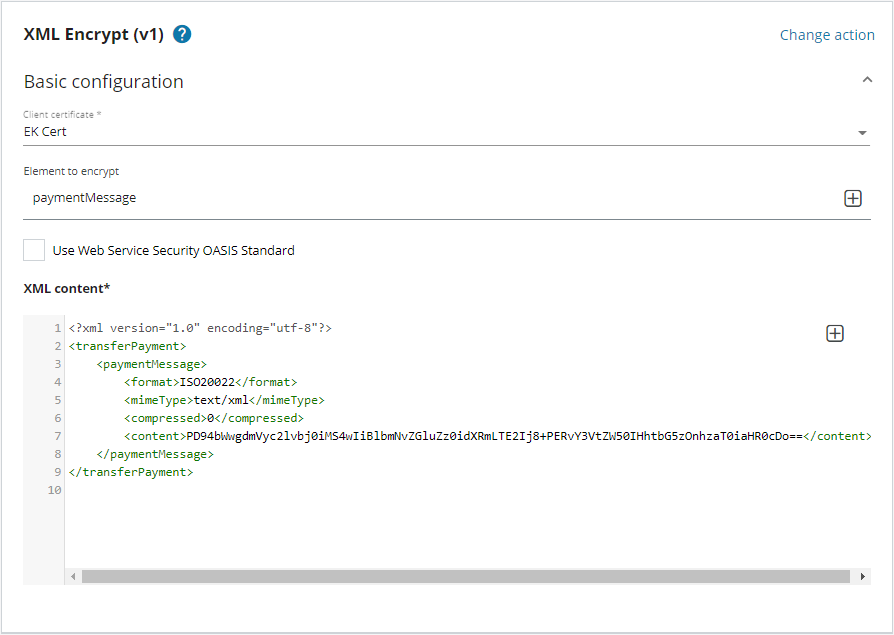XML Encrypt
Description
The XML Encrypt action applies an XML encryption to XML formatted data.
This action is based on a RSA asymmetric cipher with public and private keys pairs. Typically, this action encrypts XML content with the public key of the recipient, so that the recipient is the only one which can decrypt it with its matching private key.
The counterpart of this XML Encrypt action is the XML Decrypt.
Usage

The user must fulfill those fields:
-
A
Client certificateis required and it must be a certificate with a RSA Public key. -
The
Element to encryptindicates the XML element that must be encrypted within the entire given XML content. This field is optional. Note that if element to encryt is empty, the action will just encrypt the entire XML string given inXML contentfield, or the first child of the SOAP Body when using Web Service Security (WSS) OASIS Standard. -
(Optional) The
Use Web Service Security OASIS Standardis an optional flag that can be set to indicate we want to encrypt a SOAP XML by using the Web Service Security (WSS) OASIS protocol. More detail here about OASIS Standard Specification. When unchecked, a basic encryption is performed according to W3C Recommendation. -
The
XML contentcan either contain an actual XML string or a reference to an XML output of a previous step by using the [+] button.
Basic XML encryption
The basic encryption is performed when the Use Web Service Security OASIS Standard remains unchecked and is done according to W3C Recommendation.
Example: given the following XML content:
<?xml version="1.0" encoding="utf-8"?>
<transferPayment>
<paymentMessage>
<format>ISO20022</format>
<mimeType>text/xml</mimeType>
<compressed>0</compressed>
<content>PD94bWwgdmVyc2lvbj0iMS4wIiBlbmNvZGluZz0idXRmLTE2Ij8+PERvY3VtZW50IHhtbG5zOnhzaT0iaHR0cDo==</content>
</paymentMessage>
</transferPayment>
NOTE: If the
Element to encryptfield is empty, the XML Encrypt action will encrypt the whole XML content.
In the case that the Element to encrypt field contains the value "paymentMessage" then the result will look like that:
<?xml version="1.0" encoding="utf-8"?>
<transferPayment>
<EncryptedData Type="http://www.w3.org/2001/04/xmlenc#Element" xmlns="http://www.w3.org/2001/04/xmlenc#">
<EncryptionMethod Algorithm="http://www.w3.org/2001/04/xmlenc#aes256-cbc"/>
<KeyInfo xmlns="http://www.w3.org/2000/09/xmldsig#">
<EncryptedKey xmlns="http://www.w3.org/2001/04/xmlenc#">
<EncryptionMethod Algorithm="http://www.w3.org/2001/04/xmlenc#rsa-oaep-mgf1p"/>
<KeyInfo xmlns="http://www.w3.org/2000/09/xmldsig#">
</KeyInfo>
<CipherData>
<CipherValue>DeZulSs6L5Gag1b03pfp/FuynV6saKt2QYLDFuzfobQZFkMBZlWiUzKww...</CipherValue>
</CipherData>
</EncryptedKey>
</KeyInfo>
<CipherData>
<CipherValue>VbNUeS3AXG9IDScolGAS3Q77CfIEK4K/Gezi0osh+OmIPGAiz0a8vJp9oeknyEfaW...</CipherValue>
</CipherData>
</EncryptedData>
</transferPayment>
Explanation for the Basic XML encryption:
The whole element paymentMessage is replaced by its encrypted version: element EncryptedData.
The encryption has been done with a random symmetric key that is, itself, encrypted with the public key of the given certificate.
The EncryptedData is made of:
EncryptionMethodcontains the method used for encryption (that is AES256 by default)KeyInfocontains theEncryptedKeywhich contains the information related to the AES symmetric key that has been generated for that purpose and encrypted here with to the public key of the given certificateCipherDatacontains the encryption value of the elementpaymentMessagethat we want to encrypt.
XML encryption using Web Service Security (WSS) OASIS Standard
The WSS OASIS Standard encryption is performed when Use Web Service Security OASIS Standard is checked and is done according to OASIS Standard Specification.
Note that the use of WSS OASIS Standard option requires a SOAP XML content. If not then an error is returned.
Example: given the following SOAP XML content:
<?xml version="1.0" encoding="utf-8"?>
<s:Envelope xmlns:s="http://schemas.xmlsoap.org/soap/envelope/">
<s:Header>
</s:Header>
<s:Body xmlns:xsi="http://www.w3.org/2001/XMLSchema-instance" xmlns:xsd="http://www.w3.org/2001/XMLSchema">
<transferPayment xmlns="http://bankconnect.dk/schema/2014">
<paymentMessage>
<format>ISO20022</format>
<mimeType>text/xml</mimeType>
<compressed>0</compressed>
<content>PD94bWwgdmVyc2lvbj0iMS4wIiBlbmNvZGluZz0idXRmLTE2Ij8+PERvY3VtZW50IHhtbG5zOnhzaT0iaHR0cDo==</content>
</paymentMessage>
</transferPayment>
</s:Body>
</s:Envelope>
Note that in the case of WSS OASIS Standard, if
Element to encryptis empty, then the action will encrypt the first child element found in theBody. If none, then action will return an error.
The encryption result will look like that:
<?xml version="1.0" encoding="utf-8"?>
<s:Envelope xmlns:s="http://schemas.xmlsoap.org/soap/envelope/">
<s:Header>
<wsse:Security xmlns:wsu="http://docs.oasis-open.org/wss/2004/01/oasis-200401-wss-wssecurity-utility-1.0.xsd" s:mustUnderstand="1" xmlns:wsse="http://docs.oasis-open.org/wss/2004/01/oasis-200401-wss-wssecurity-secext-1.0.xsd">
<wsse:BinarySecurityToken EncodingType="http://docs.oasis-open.org/wss/2004/01/oasis-200401-wss-soap-message-security-1.0#Base64Binary" ValueType="http://docs.oasis-open.org/wss/2004/01/oasis-200401-wss-x509-token-profile-1.0#X509v3" wsu:Id="X509-a450ae60-a116-4dd5-bb9f-a0987320cf43">MIICojCCAYqgAwIBAgIIIHYpe7NybIkwDQYJKoZIhvcNAQELBQAwETEPMA0GA1UEAxMGZm9vYmFyMB4XDTIyMTAyODA4NDY...</wsse:BinarySecurityToken>
<xenc:EncryptedKey Id="EK-4fa5d278-fe3c-4acc-8a53-2b078aa86b84" xmlns:xenc="http://www.w3.org/2001/04/xmlenc#">
<xenc:EncryptionMethod Algorithm="http://www.w3.org/2001/04/xmlenc#rsa-oaep-mgf1p"/>
<ds:KeyInfo xmlns:ds="http://www.w3.org/2000/09/xmldsig#">
<wsse:SecurityTokenReference wsu:Id="Id-0a9bd273-6547-4b61-a5c9-fb4f39f28407">
<wsse:Reference URI="#X509-a450ae60-a116-4dd5-bb9f-a0987320cf43" ValueType="http://docs.oasis-open.org/wss/2004/01/oasis-200401-wss-x509-token-profile-1.0#X509v3"/>
</wsse:SecurityTokenReference>
</ds:KeyInfo>
<xenc:CipherData>
<xenc:CipherValue>Ew8q/zFQeMClIXlePr2lJfpX0icITU/iZ1oEOAHyXEBBzPv5vMKkpTZYZ330xHx...</xenc:CipherValue>
</xenc:CipherData>
<xenc:ReferenceList>
<xenc:DataReference URI="#ED-198b6070-e1d4-4120-8c9d-c991c47204df"/>
</xenc:ReferenceList>
</xenc:EncryptedKey>
</wsse:Security>
</s:Header>
<s:Body xmlns:xsi="http://www.w3.org/2001/XMLSchema-instance" xmlns:xsd="http://www.w3.org/2001/XMLSchema">
<xenc:EncryptedData Id="ED-198b6070-e1d4-4120-8c9d-c991c47204df" Type="http://www.w3.org/2001/04/xmlenc#Content" xmlns:xenc="http://www.w3.org/2001/04/xmlenc#">
<xenc:EncryptionMethod Algorithm="http://www.w3.org/2001/04/xmlenc#aes256-cbc"/>
<ds:KeyInfo xmlns:ds="http://www.w3.org/2000/09/xmldsig#">
<wsse:SecurityTokenReference d5p1:TokenType="http://docs.oasis-open.org/wss/oasis-wss-soap-message-security-1.1#EncryptedKey" xmlns:d5p1="http://docs.oasis-open.org/wss/oasis-wss-wssecurity-secext-1.1.xsd" xmlns:wsse="http://docs.oasis-open.org/wss/2004/01/oasis-200401-wss-wssecurity-secext-1.0.xsd">
<wsse:Reference URI="#EK-4fa5d278-fe3c-4acc-8a53-2b078aa86b84"/>
</wsse:SecurityTokenReference>
</ds:KeyInfo>
<xenc:CipherData>
<xenc:CipherValue>6znGjVGrO8TeFokTLO6qVPtQBAZBId61GkHuThAdpIiPcZ6m1b9ouQQ7xmpexArCPoFF...</xenc:CipherValue>
</xenc:CipherData>
</xenc:EncryptedData>
</s:Body>
</s:Envelope>
Explanation for the WSS OASIS Standard XML encryption:
-
The element
transferPayment, that is the first child element of the initial SOAP Body, has been replaced by its encrypted version:xenc:EncryptedDataelement -
A new Security element
wsse:Securityhas been created in the SOAP Header. This Security element is made of:-
xenc:EncryptedKeythat contains the encrypted value of the symmetric key that has been generated and used to encrypt the element to encrypt. -
wsse:BinarySecurityTokenthat contains the base64 encode of the public key of the given certificate and that has been used to encrypt the symmetric key above.
NOTE: Unlike in Basic Encryption, the
EncryptedKeyelement is not located in theEncryptedData, but in thisSecurityelement. -